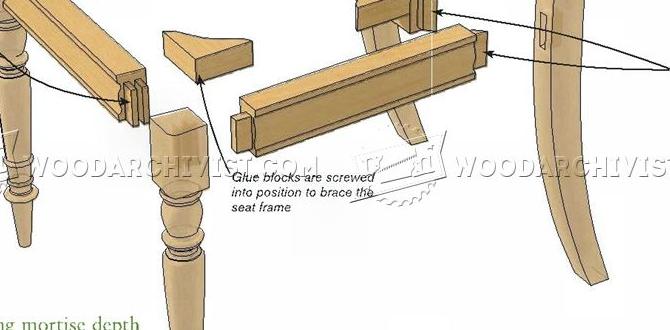Have you ever looked at an old piece of wood furniture and thought it looked tired? Many of us have that one table or chair that just needs a little love. Restaining wood can breathe new life into it. The task might seem tricky, but with the right tips, you can achieve a flawless finish.
Did you know that wood can change its color over time? Maybe it faded from sunlight or lost its shine. Whatever the reason, restaining wood is a fun project that can transform your space. Imagine turning a dull brown chair into a rich mahogany masterpiece.
In this article, you’ll learn expert tips to help you restain wood easily. We will cover everything from choosing the right supplies to applying the stain smoothly. You’ll be amazed by how simple it is to make your wood pieces look like new again!
Table of Contents
How To Restain Wood: Expert Tips For A Flawless Finish

How to Restain Wood: Expert Tips for a Flawless Finish
Restaining wood can breathe new life into old furniture. Start by choosing the right stain color to enhance the wood’s natural beauty. Proper preparation is key—clean and sand the surface to ensure smooth application. Did you know that layering different stains can create unique effects? Always test on a small area first! Use a brush for even coverage, and don’t rush. With these expert tips, your wood will shine like new again.Understanding the Wood Staining Process
Explanation of wood staining and its purpose. Different types of wood stains available.Wood staining adds beauty and protection to your wood items. It helps highlight natural grain patterns. The right stain can change the wood’s color and enhance its appeal. There are several types of wood stains available:
- Oil-based stains: These provide deep color and durability.
- Water-based stains: Quick drying and easy to clean.
- Gel stains: Thick texture, perfect for vertical surfaces.
- Transparent stains: Allow natural wood features to show through.
- Solid stains: Create an opaque finish, hiding wood features.
Choosing the right stain can really enhance your project!
What is the purpose of wood staining?
The purpose of wood staining is to enhance and protect wood surfaces. It adds color, highlights grain, and prevents damage from moisture and sunlight.
Why use different types of stains?
Different stains offer unique effects and protection. Some are better for furniture, while others are suited for outdoor items.
Preparing the Wood Surface
Steps to clean and sand the wood properly. Importance of removing old stain and finish.Before you make wood sparkle, clean and sand it first. Start by wiping the surface with a damp cloth. This removes dust and dirt. Next, grab a sanding block. Sand the wood in the direction of the grain. Make it smooth like a baby’s bottom—seriously! Removing old stains and finishes is crucial, as they can ruin your fresh coat. For a flawless finish, you need a clean canvas. Here’s a quick table to help:
| Step | Action |
|---|---|
| 1 | Wipe down with a damp cloth |
| 2 | Sand the wood gently along the grain |
| 3 | Check for old stains and remove them |
By prepping correctly, your wood will be ready for that stunning finish. Remember, a little effort leads to big smiles!
Selecting the Right Stain Color
Tips for choosing the appropriate stain color. Considerations for matching interior decor or wood types.Choosing the right stain color can transform your wood items. Think about your room’s color scheme. Do you want a bold look or something cozy? Consider matching the stain to your furniture or walls. Here are some tips to help you:
- Choose colors that blend well with your other decor.
- Consider the wood type; softwoods may look different than hardwoods.
- Test a small area first to see how it looks.
Remember, the right stain can brighten or warm up your space!
What factors should I consider when selecting a stain color?
Look at your home’s overall style. Do you prefer modern or traditional? Consider light and dark shades based on what fits best!
Application Techniques for a Flawless Finish
Recommended methods for applying stain evenly. Discussion of brush, cloth, and spray application options.For a perfect finish, applying stain evenly is key. You can use brushes, cloths, or sprayers. Brushes are great for detail but can leave marks if you’re not careful. Cloths allow for a smooth swipe, perfect for those big areas. Sprayers can cover a lot quickly, but practice first unless you want an accidental Jackson Pollock on your wall!
| Application Method | Best For | Tips |
|---|---|---|
| Brush | Detail work | Use long, smooth strokes |
| Cloth | Larger surfaces | Wipe off excess for even color |
| Spray | Speed & coverage | Stay back to avoid drips! |
Choose your method wisely, and you’ll be the Picasso of wood staining in no time! Remember, practice makes perfect. Happy staining!
Drying and Curing Times
Importance of proper drying times between coats. Tips for ensuring the stain cures effectively.Proper drying times between stain coats are crucial for a perfect finish. If you rush, you might end up with a sticky mess instead of a beautiful wood surface. Aim to wait at least 24 hours between coats. This gives the stain time to bond. Here’s a fun tip: set a timer! It’s like having a mini countdown to your beautiful furniture.
To make sure your stain cures effectively, keep the wood in a warm, dry area. Dust and humidity are not your friends here. Keep an eye on temperature, too; a range of 60 to 80 degrees Fahrenheit is ideal. Remember, patience is a virtue, and it can save your wood from looking like a sad science project.
| Tip | Importance |
|---|---|
| Wait 24 hours between coats | Prevents stickiness |
| Keep in a warm, dry area | Promotes better curing |
| Check temperature | Ensures optimal drying |
Maintaining Your Stained Wood
Best practices for maintaining stained wood finishes. Common pitfalls to avoid for longlasting results.Taking care of your stained wood can be a breeze with a few simple steps. First, always dust your surfaces to keep them looking shiny. Use a soft cloth or a feather duster—no one wants a grumpy wood finish! Next, remember that water is not your best friend. Instead of a soggy sponge, opt for a damp cloth. Think of your wood like a cat: it hates getting wet!
| Best Practices | Common Pitfalls |
|---|---|
| Dust Regularly | Using Too Much Water |
| Use a Soft Cloth | Skipping Refinishing |
| Avoid Harsh Chemicals | Neglecting Scratches |
Lastly, avoid harsh chemicals. They can ruin your beautiful finish. If you spot a scratch, address it right away! A little TLC goes a long way in making your wood look flawless for years. Remember, a well-maintained piece of wood can outlast even your favorite pair of shoes!
FAQs About Wood Staining
Common questions and answers related to wood staining. Troubleshooting tips for common issues faced during the process.Got questions about staining wood? You’re in good company! Here are some common queries and their answers to help you out. First off, how long should I wait between coats? Usually, 4-6 hours is perfect, giving the wood time to drink up that stain. If you see blotches, don’t panic! Lightly sand the area and apply a pre-stain conditioner. Lastly, what should I do if my stain looks uneven? Try applying more coats evenly!
| Question | Answer |
|---|---|
| How long to wait between coats? | 4-6 hours |
| What if it’s blotchy? | Sand and use a pre-stain conditioner |
| Uneven stain? | Apply more coats evenly! |
Conclusion
In conclusion, restaining wood can transform your furniture. Start by cleaning and sanding the surface. Choose the right stain and apply it evenly. Always test first! Patience can lead to a flawless finish. You can easily refresh your wood items with practice. For more tips, dive into expert guides or watch helpful videos. Happy staining!FAQs
What Are The Essential Steps To Prepare Wood For Restaining To Ensure An Even Finish?To prepare wood for restaining, start by cleaning the surface. Use soap and water to remove dirt. Next, sand the wood with sandpaper to make it smooth. This helps the new stain stick better. Finally, wipe away any dust before applying the stain.
How Do I Choose The Right Type Of Wood Stain For My Project, And What Factors Should I Consider?To choose the right wood stain, first think about the color you want. Look at how the wood will be used, like inside or outside. Check if you need the stain to protect the wood from water or sun. Finally, consider how easy it is to apply and clean up.
What Techniques Can I Use To Apply Wood Stain Evenly And Avoid Blotching?To apply wood stain evenly, you should start by sanding the wood smooth. Use a clean cloth to wipe off dust. Then, try using a foam brush or a cloth to apply the stain. Work in small areas and spread the stain quickly. To avoid blotching, you can use a pre-stain conditioner first. This helps the wood soak up the stain evenly.
How Can I Properly Clean And Maintain Furniture Or Surfaces After Restaining To Preserve The Finish?To clean and maintain your furniture after restaining, start by using a soft, dry cloth. Wipe away any dust or dirt gently. If it gets sticky, use a damp cloth with a tiny bit of soap, then dry it well. Avoid harsh cleaners because they can ruin the finish. To keep it nice, you can add a thin layer of furniture polish every few months.
What Common Mistakes Should I Avoid When Restaining Wood To Achieve A Flawless Look?To get a perfect look when restaining wood, avoid these mistakes. First, don’t skip sanding the wood. This helps the new stain stick better. Next, don’t rush the drying time. Make sure each layer is completely dry before adding more stain. Finally, use a clean cloth to wipe off extra stain. This helps make the finish smooth and nice.




